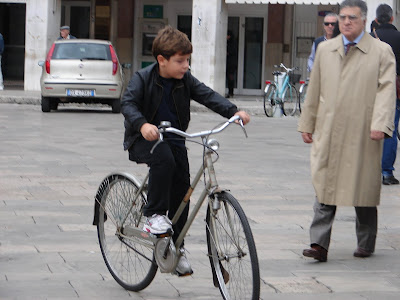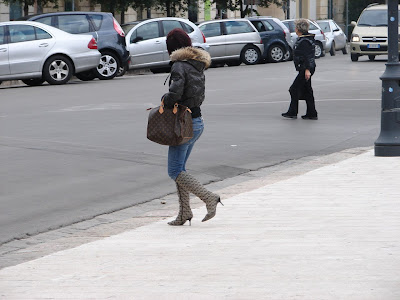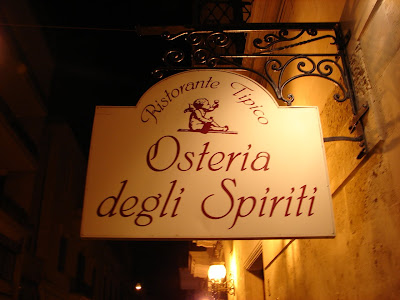
Karen got up early to go looking for new shoes. Our clothes are still wet from the night before, but they would dry. Her shoes, on the other hand, are ruined. I teased Karen that she would come back with the thigh high boots that all the fashionable Italians are wearing. She came back with a nice pair of relatively sensible shoes.

No time for breakfast at the Prestige (a decision we would later come to regret) because we have to meet Cinzia outside the old town walls for our wine tour. The rains from the night before had caused extensive damage, flooding and downed tree limbs. Only a couple inches of rain that fell last night, but I think there was so much damage due to the fact that there is a bed of limestone just a few feet below ground. The water simply cannot be absorbed into the rock bed.

Cinzia drives us in her Alfa Romeo to wine country, only ½ hour from Lecce. On the ride (and detours due to road flooding) I see many olive groves and vineyards sitting in flood waters. Who knows how this will affect the vines (the grapes have already been harvested for the year) but I’m sure the olive crop will be damaged since this is harvest time Cinzia is perhaps the most knowledgeable wine person we have ever met. With an MBA from Harvard, she worked in investment banking before returning home to Solento in 2005 to start a cooking school with her sister.

Cinzia has consulted wineries in the area, so she does wine tours as well. Talking and driving, Cinzia tells us about the major grape varieties in Solento, Primitivo and Negromonica. When I suggested Primitivo is similar to Zinfindel, she said that it is similar, but growing conditions, wind, sun and soil are so different that you cannot compare the two. After stopping to asking directions (we were detoured several times due to flooding) we were told to go two blocks, turn right and ask someone else. When we got to Candida Winery, we were greeted by Francesca, who works in marketing and is in charge of exporting. Unfortunately, there is no current importer for this winery in the US. But Francesca is looking hard to find one. If Francesca hadn’t apologized for her English, you would never know she is uncomfortable with the language. She speaks quickly with near flawless pronunciation and an accent that sounds closer to British than anything. Francesca told us that Candida produces 2 million bottles a year. The wine is aged in French oak and stainless steel. Depending on the variety, the wine may spend no time in oak or three months, up to three years in the barrel. I’ve never seen such a clean winemaking process. Everything is spotless.

We go to the huge tasting room where Francesca decanted the wine. We sample two amazing varieties of Negromonica. Since Candida doesn’t ship to the US, we have to buy bottles at the winery and take it with us. This breaks our cardinal rule of never taking anything with you that you can’t carry in your backpack. Now we would have to look for a suitcase to carry all this wine!

On our way to the next winery, Cinzia told us about the pruning method for the Primitivo. This method makes the vines look like the old Zin vines we have seen in California. But the ages of these vines would put those New World vines to shame. Some are 70-100 years old. Imagine working the vines your great grandfather planted. Cinzia also tells us about the roofs of the vine. They dig deep into the subsoil and grab the limestone. This means the vines have access to the water between the rocks and rarely need irrigation. Cinzia says this can give the wine a pleasant mineral, almost salty flavor.

Cinzia has consulted at Castello Monaci. So, they know her well and tell her to show us around. The winemaker stops by and chats with Cinzia. Then we go upstairs to taste! Angelo pours the wine and Cinzia translates his description. The Primitivo was by far the best we have ever tasted. We thank Angelo and he gives us the name and number of their importer in the US. Don’t be surprised if you see a tractor trailer truck pull up in Hope Valley to drop off a few pallets. We buy a couple of bottles just so we are sure to have some. Cinzia drops us back at Lecce and we give her a bottle of her favorite Primitivo as a thank you.

A word about prices. Since we had not seen or tasted wines from these wineries before, Karen and I both tried to guess the price of the wines as we tasted them. In the states, we agreed, these would be $40-$50 a bottle. When we went to the warehouse, imagine our surprise when the wines cost 1/3 of that. For us, of course, that price goes up when we try to figure out how we are getting the wine home. The other thing is that Solento is an up and coming wine region. So, while the wine might be comparable to top flight wines in Napa or France, the prices do not reflect the quality.

After siesta (did I mention how I love the siesta?) Karen heads out looking for a bag for our wine while I read some more of my book “Christ Stopped at Eboli.” When Karen comes back, she takes me shopping (my favorite activity, note sarcasm here) for luggage. It soon becames apparent we are going to spend a lot of money. Duffel bags and soft sided cases, while inexpensive, will not do the job. We cannot risk breaking the bottles. So, we buy “The Beast.” El Beasto will fit lots of bottles. I manhandle The Beast up the narrow staircases of the Pretige and couldn’t help but think of how the heck I was going to get it back down the stairs stuffed with heavy bottles. Once upstairs, I pack the case and find I have a little extra room. Luckily, Renata is at the Prestige, so I ask if can buy 5 litres of her family’s olive oil. She says she doesn’t have any right now. My heart sinks. Renata gets on the phone, calls her mom, then her sister who arrives 10 minutes later with a huge jug of olive oil! Renata and Steve pack it up and I slide it into the case; perfect fit.

Karen and I head out to dinner. It’s raining and the streets are deserted. Passagiatta cancelled. Funny thing about rain in Lecce. People panic when it rains in Lecce like Rhode Islanders panic when it snows. Even a few drops or a little drizzle brings out a dozen umbrella vendors hawking their wares. They will aggressively approach you if you don’t have an umbrella with you. Tonight it is raining hard and nothing is open. We walk for an hour and everywhere we go, places are closed for the night. No one is out, so no reason to stay open. Finally, we walk to the only 5 star hotel in Lecce. Soaking wet, we ask the desk clerk if the restaurant is open. The very professional women behind the desk tries not to look at us askance, but it is easy to read her mind; “Who are these vagabonds?” We sit down in the restaurant and Karen goes to the bathroom to freshen up (there’s no hope for me). When she comes back, we are served some amazing rolls with sundried tomatoes and olives (pits not removed) baked in. No butter or olive oil served with the bread (it’s not needed). The vegetarian items on the menu were limited so Karen gets the pumpkin soufflé with back truffle while I get the pureed fava beans with sautéed chicory. Both dishes are out of this world, but I’m glad Karen shared her soufflé as it was truly an outstanding dish. For and entrée the waiter said the chef could make us some roasted vegetables with cheese, “maybe some mozzerella?” We decide to split the entrée and good thing. Tomato, mushroom, zucchini and more. The star of the show is what turned out to be a huge cheese plate. At least four pieces each of moz, grana padana, piave, gouda, and maybe a cheddar plus a couple pieces of brie. Three small bowls accompany the cheese. Honey, pickled onion and pomegranate jam. I tried every combination of cheese and accompaniment (honey and brie is my fave) and then mixed cheese and grilled veggies (zucchini and gouda, Yum!) and then bread and cheese. The mozz on the bread is so fresh it is sweet. Heaven!
 Karen and I haven't been to Italy since 2001. Since that time, we very much wanted to return. Our last trip in 2001 was in northern Italy; Tuscany, Bologna, Cinque Terre. This time we wanted to explore a different region of Italy. Our research dug up Puglia, the heel of Italy which sticks out into the Adriatic Sea and Ionian Sea. We thought it would be ideal as it is off the beaten path and has few American tourists. Puglia is known as a world class wine region and proudly serves "peasant food" featuring local vegetables and homemade pasta.
Karen and I haven't been to Italy since 2001. Since that time, we very much wanted to return. Our last trip in 2001 was in northern Italy; Tuscany, Bologna, Cinque Terre. This time we wanted to explore a different region of Italy. Our research dug up Puglia, the heel of Italy which sticks out into the Adriatic Sea and Ionian Sea. We thought it would be ideal as it is off the beaten path and has few American tourists. Puglia is known as a world class wine region and proudly serves "peasant food" featuring local vegetables and homemade pasta.





















































